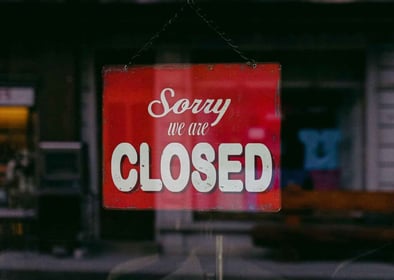Unhinged Times: Navigating B2B Marketing During COVID-19 and Economic Recession
April 06, 2020
7 Minute Read


At unprecedented rates, COVID-19 changed everything, including how the world does business. Gripped by pandemic, the global economy ground to a halt and opportunistic, pop-up-garage-shop predators started charging $20 for a roll of toilet paper.
We can all learn an invaluable lesson from these hoarders-for-profit: those of us with a conscience must continue to be thoughtful and intentional about how we do business.
As digital marketers, we need to stop saying “B2B Marketing.” What?! That’s right: get it out of your system. Call it “B2B Marketing” one last time and be done with it. Wait! We’re B2B marketers! We hear you—we do—but hear us out, and, for the time being, stop calling it “B2B Marketing.”
From B2B marketer to invaluable partner
In times of economic recession, clients need their digital agencies. It’s true. While the world waits for consumer behavior to get back to normal, the benefits we provide are both practical and powerful, and may just let our clients breathe a sigh of relief.
We already have the resources, data and creative expertise. So that we can provide a truly invaluable service to our clients, starting right now, let’s add to the list, shift our thinking and instead of marketers, consider ourselves’ owner-partners with a stake in our clients’ businesses.
Remember this: times are scary. Our clients need flexibility and compassion. They need reassurance and empathy. Ask them: “How can we help? What can we do for you to help you catch your breath?”
And from there…
Toss the 2020 B2B marketing playbooks and create new plans
With great turmoil comes even greater creativity. We need to keep doing our jobs the best we can—even with everyone at home, kids home-schooling, and caring for our family and neighbors.
Our new reality is evolving so fast we need to keep our plans flexible and be ready to adapt. Here are a few places to start.
Prospecting for the future
We can’t all be suppliers of medical equipment and gear, and as such, those of us not on the COVID-19 frontlines should plan on sales taking a hit over the next couple of months.
Let’s talk prospecting: a great way to start is to realize even if sales dip, we can still fill our pipeline, and from there, adapt our plans. Focus on early-stage prospecting with the right message. When reaching out to current clients and/or prospects, ask them: “How can we help you?”
The months ahead will be tough on sales. Remember, it’s time to kick comfort aside, ditch the pitch and stop selling the way we have always done it. Get creative in your message – don’t pivot to an overly optimistic message. In a word: empathy.
Set the right tone for content and communication
Messaging is key. It needs to be sensitive to our new normal and reality. Content should not ignore the ongoing pandemic, nor should it come across as trying to capitalize on it.
Right now, the best content helps people and builds trust Try these:
- Podcasts
- Long-form articles and video
- Training and educational content
- Stories that humanize a brand
World-class social selling
With so many working from home, social selling is essential. LinkedIn360 is ideal in leveraging connections with content, improving marketing leads and upping those sales close rates. Optimized Salesforce profiles are brand essential.
Simply put, plan for a whole lot of social outreach, especially through LinkedIn.
What to expect from analytics data
For the immediate future, plan on erratic data. Many B2B brand platforms rely on corporate IP addresses. With the world on lockdown and most people working from home, this data is either not available or completely askew.
Remote work changes the game. Actually, it changes the entire sport. Ad scheduling and IP-targeted account-based marketing tools are going to be out of whack. Upcoming data numbers and analytics will reflect this wackiness.
As we all look at your data from the past two weeks, we must not make assumptions based on what has always worked for us. At the same time, we shouldn’t over-adjust right now either. Unless data shows a clear drop-off (or spike), the best approach will blend patience with an observation of short-term trends.
Pivot live event budgets
For the foreseeable future, live events have gone virtual. This is not an excuse for saving the event budget or earmarking it as a “recession saving.” Instead, this is a great opportunity to create new connections.
Every brand has, or should have, a wish list of digital projects, platforms and channels to test. Even with so much uncertainty, now is a good time to reallocate that event budget to build another area of business.
What to do in place of live events
Events and conferences across the country have been canceled. Some have been postponed and rescheduled for later in the year while others are canceled until next year.
No matter the size, many events, such as the Adobe Digital Experience, Microsoft’s MVP Summit, and the Google Cloud Next conference, have gone virtual.
Despite these live event cancellations, it’s imperative we maintain the lead flow these events drive, which is why virtual events are an excellent option. Online events can create that much-needed sense of connection – even while we are working virtually.
Social distancing doesn’t have to be a disconnect: we just have to change the way we connect with each other and we can absolutely still look forward to our favorite learning and networking events and conferences.
Some ideas for events to host include:
- Industry-focused thought-leadership webinar
- Industry-focused virtual mini-conference
- Regular round-table discussions
To ensure successful virtual events, we recommend reallocating a portion of conference and event budgets toward ad spend targeted at spreading awareness, encouraging attendance of these online gatherings. To promote and reach your audience, we would recommend using the following channels:
- LinkedIn Ads
- LinkedIn 1:1 Reachouts
- Google Ads with lead form extensions
- Facebook Ads
- New content creation, ie., articles
- Instagram (for brands with Instagram audiences)
Key takeaways
A lot has changed in a very short time. While much uncertainty remains, we’re finding that B2B brands can relate to their audience now more than ever before. By offering support and helpful insights, we can demonstrate our value, build our pipeline and form stronger, trusting relationships along the way. Afterall, it feels good to do good.

Dan Golden
Dan Golden is a veteran digital marketing executive & speaker. He liked to predict the future of digital marketing and is damn good at it. Beyond trendspotting, he has an insatiable desire to know what works and that means spending time auditing accounts, testing tactics, and diving into analytics. Dan is also a Forbes and HuffPost contributor, as well as a Lecturer at Northwestern University and DePaul University.
CATEGORIES
SUBSCRIBE TO OUR BLOG
Stay up to date with the latest industry best practices in digital marketing!























.png?width=339&height=179&name=Webinar%20Banner%20(1).png)



.png?width=339&height=179&name=July%20Webinar%20(Newsletter).png)

.png?width=339&height=179&name=Webinar%20Banner-April-02%20(1).png)
%20(4).png?width=339&height=179&name=Webinar%20Banner-May-02%20(1)%20(4).png)




.png?width=339&height=179&name=March%202023%20Webinar%20Ad%20(autoresponder).png)

















































